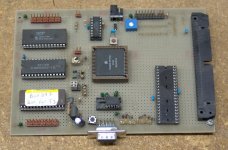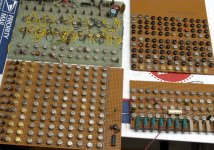Keypad...you had a keypad?
You had switches ?
The Sinclair Spectrum had rubber blocks for keys with a membrane under it with contacts in it. The keyboard had up to 5 levels on each key which you needed double jointed fingers to get the right combination.
I recycled one of those. In the eraly 70s i was programming an IBM360 via punch-cards (as a student), i could imagine how hard programming with switches would be.
dave
My first FORTRAN class at Ga Tech in '74, we had to use those Hollerinth punch-cards, too. What a mess! And don't forget what they did to AL Gore in Florida....still messing things up - 26 years later. wo
 rks
rksI didn’t have to do much FORTRAN. Head of the dept was one of the authors of ALGOL W and that was my 1st programming language.
dave
dave
Neat, my first language was Fortran as well. Punched cards of course and a chain printer for output. Later we used terminals (dumb types). I passed and that was all that mattered back then.
-Chris
-Chris
If you have the original DVD, check-the special features. I think they filmed that in Iceland, and she got got hypothermia in that scene from bad seals on her drysuit. I too, noticed how unbelievably agile they ALL were - the movie "Pandorum" was more careful about that. But the physics errors in that movie (and in "Gravity") didn't kill my buzz - I just kept having to skip back to see what I'd missed while rolling on the floor laughing.
Movies are watched by people who don't like cinema but want to be entertained.
Music is listened by people who don't like music but want to be entertained.
{}...but want to be entertained
Vishnu said:should have said 33 MHz 386.
The first machine able to run quake at 640x480 what a souvenir !
Last edited:
So much the better.
SSM2131 is obsolete - may be why they didn't pay to renew?
No it timed out. >20yr.
No it timed out. >20yr.
The NE5532 and the TL071 are older, why ?
The NE5532 and the TL071 are older, why ?
Don't understand the question, they were done in the 70's or early 80's so of course they are older. I was referring to the Alexander amp patent it was granted in 1992 so it has run out and the circuit is now in the public domain.
Don't understand the question, they were done in the 70's or early 80's so of course they are older. I was referring to the Alexander amp patent it was granted in 1992 so it has run out and the circuit is now in the public domain.
Oops sorry, thanks to have take some time in order to inform me.
The IGBT are neither produced anymore... it is not really a renew that is needed, more a redesign 😀
My first attempt at programming was in 1980 on a Z80 micro-professor........Keypad...you had a keypad? Hexadecimal display? Look up the Mark 8 - July 74 Radio Electronics - (8008-based)...... Neat, my first language was Fortran
My first "computer" was a piece of perf board with a MC6800 chip, 8 X 2012 static rams, a MIKBUG monitor rom, a MC6850 serial port chip, a MC6820 parallel port chip, and some glue chips to make clock, baud rate, and bus transceivers. All of these were point to point connected by soldering with wire wrap wire. Data and program entry was via an old teletype machine at 110 baud. I didn't have enough memory to run the assembler, nor a way to enter it, so all programming was done by looking up the necessary opcodes and keying them into the teletype. It was early 1975.
Within a year SWPTC (Tiger Amps) would release their 6800 computer system. I bought one. Myself and some friends who worked at Motorola would make at least a dozen clones of that machine. We created some SS50 bus boards and a few programs for that machine and even sold a few.
My SWPTC grew to take up most of a 6 foot workbench. It used two SS50 motherboards ran a overclocked MC6809 CPU and had 96K of memory (3 X 32 K banks switched by parallel port). There was an RTOS (RT-68MX I think). As technology progressed I kept building my own Motorola and Microchip based computers, mostly for dedicated projects like an Electronic Fuel Injection computer for my hot rod.
I still have some of those hand wired boards just because I can't throw away something small that I spent a lot of time on, even if an Arduino could eat it for lunch today!
The first two pictures are of a MC68HC11F1 EVB I built. The third is of a digital fuel injection box that I built. It was not totally complete at this time since the analog board isn't populated.
After seeing an ELP concert, I decided to build a music synthesizer. Unlike most synthesizers in 1971, mine would be digital. The only logic I could get for free in large quantities was RTL (before DTL, and TTL, CMOS wasn't even a dream). The level of integration was a single gate or flip flop per package. Like the SWPTC machine the synthesizer eventually grew to fill most of a gutted organ and cover the top of it. It did make sound, but by 1973 I had begun my 41 year career with Motorola, and made enough money to buy an ARP Odyssey. The project was scrapped, but again I saved the hand wired digital boards. I am considering firing one of those tone generator boards up to see if any of that 50 year old logic still works. (4th picture) It's not obvious in the compressed pictures, but the 1968 - 1970 date codes are readable in the original.
Attachments
FORTRAN for me, too along with some COBOL. About 1974. My neighbor owned a DEC and kept it in his house as a home business, I don't remember the model. That was the first time I'd seen a nesting program for laying out parts on a cut sheet - which I thought was pretty darn cool. His kids carry on the business to this day, tho the DEC is long retired. 🙂
I've just done a bit of major audio DIY, I moved my speakers, now I feel like I am dying and going to heaven
Did anybody listen to the Alexander amplifier using the SSM2131....any good ?.
Dan.
I did, of course - built my first one with it, but moved on to the AD845. Read my additional posts for more info....
It was early 1975.
I remember those days, people would pay $10-$20 for puzzle solving games on cassette tapes written in basic with 160 by 120 graphics.
Okay Guys
First (worked on)Commercial computer, IBM 1050, with ECL non IC logic, first Main Frame, RCA Spectra 70 model 45 with ECL integrated circuits, first computer built from scratch North Star Horizon S-100 bus Z-80 machine. First computer language program, ASM for the RCA Spectra 70. Currently enjoying Arduino for A and D computing for DIY. Anybody else ever programmed in LISP (AutoLisp)...
First (worked on)Commercial computer, IBM 1050, with ECL non IC logic, first Main Frame, RCA Spectra 70 model 45 with ECL integrated circuits, first computer built from scratch North Star Horizon S-100 bus Z-80 machine. First computer language program, ASM for the RCA Spectra 70. Currently enjoying Arduino for A and D computing for DIY. Anybody else ever programmed in LISP (AutoLisp)...
I did, of course - built my first one with it, but moved on to the AD845. Read my additional posts for more info....
Didn't realize the AD845 might be at end of life. I do appreciate your mention of my AD797 we still have not figured out why it outperformed all the other 1nV op-amps in LIGO's circuit.
. Anybody else ever programmed in LISP (AutoLisp)...
Tried and failed. Did work with a CAD guy once who absolutely loved it. I think he caught the bug whilst working for SSL who used it extensively.
Alexander Amp 'redesign' ? Why? You guys should actually READ stuff before replying -
Read my earlier posts more carefully...as well as the app note. The board will work with either IGBTs or FETs with no redesign necessary. I built my first one with the SSM-2131, because that was what the original design used, but I used a single pair of complementary Motorola power FETs per channel. Running my Klipsch LaScalas with 50-70W per channel was more than adequate to reach orchestral volume levels. I then replaced the 2131 with the AD-845, because I'd been designing a lot of things with it, and liked it better. Under normal conditions, they were indistiguishable, but with its far superior specs (THD at 100kHz is -107 dB, primarily 2nd harmonic - the third is 5-6 dB below that; I challenge anyone on this website to match that with a discrete design costing under $25 that produces those same specs, in every one you build, with no tweaking), it outshined the 2131 hands down.
And look at the specs for the amp itself - THD at 20 kHz, 50W into 8 ohms is 10 parts per million. IM distortion is 4 ppm. The AES has a special term for people who can hear that - 'liars'.
Oops sorry, thanks to have take some time in order to inform me.
The IGBT are neither produced anymore... it is not really a renew that is needed, more a redesign 😀
Read my earlier posts more carefully...as well as the app note. The board will work with either IGBTs or FETs with no redesign necessary. I built my first one with the SSM-2131, because that was what the original design used, but I used a single pair of complementary Motorola power FETs per channel. Running my Klipsch LaScalas with 50-70W per channel was more than adequate to reach orchestral volume levels. I then replaced the 2131 with the AD-845, because I'd been designing a lot of things with it, and liked it better. Under normal conditions, they were indistiguishable, but with its far superior specs (THD at 100kHz is -107 dB, primarily 2nd harmonic - the third is 5-6 dB below that; I challenge anyone on this website to match that with a discrete design costing under $25 that produces those same specs, in every one you build, with no tweaking), it outshined the 2131 hands down.
And look at the specs for the amp itself - THD at 20 kHz, 50W into 8 ohms is 10 parts per million. IM distortion is 4 ppm. The AES has a special term for people who can hear that - 'liars'.
Last edited:
Yeah - no sweat. Marantz cd transports were built by Philips. 2 questions: what's it doing, and do you have the Service Manual?
Hi,
Yeah I have the manuals for cd63, cd63ki, cd67ose and have done a bit of modifiying of these quite successfully using Ray vd Steens list on Ray's Audio NL.
- Status
- Not open for further replies.
- Home
- Member Areas
- The Lounge
- DIY is dying



